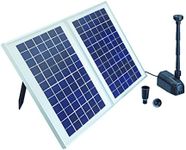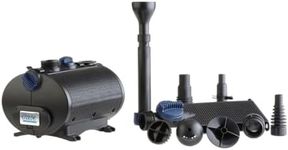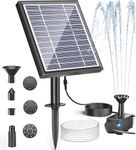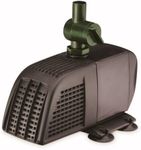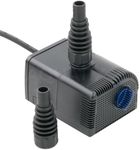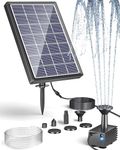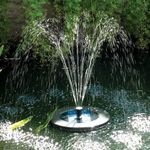Buying Guide for the Best Solar Pond Pumps
Choosing the right solar pond pump involves understanding your pond's needs and how different pump specifications can meet those needs. Solar pond pumps are eco-friendly and cost-effective, harnessing solar energy to circulate water in your pond. When selecting a pump, consider factors such as the size of your pond, the desired water flow, and the amount of sunlight your location receives. It's important to match the pump's capabilities with your pond's requirements to ensure efficient operation and maintain a healthy aquatic environment.Flow RateFlow rate refers to the volume of water the pump can move in a given time, usually measured in gallons per hour (GPH). This is crucial because it determines how effectively the pump can circulate water in your pond, which is essential for maintaining water quality and oxygen levels. Smaller ponds may require pumps with lower flow rates, typically under 500 GPH, while larger ponds might need pumps with flow rates exceeding 1000 GPH. Consider the size of your pond and the type of aquatic life you have when choosing the flow rate; more fish or plants may require higher circulation.
Solar Panel WattageSolar panel wattage indicates the power capacity of the solar panel that drives the pump. Higher wattage panels can generate more energy, which is important for ensuring the pump operates efficiently, especially in less sunny conditions. Panels can range from 5 watts to over 20 watts. If your area receives ample sunlight, a lower wattage panel may suffice, but if sunlight is limited, opt for a higher wattage to ensure consistent pump operation. Consider your local climate and the amount of direct sunlight your pond receives when selecting the solar panel wattage.
Head HeightHead height is the maximum height the pump can push water upwards, measured in feet. This is important for features like waterfalls or fountains, where water needs to be elevated. Pumps with a head height of 2-5 feet are suitable for small water features, while those with 6-10 feet or more are better for larger or more complex setups. Consider the design of your pond and any water features you plan to include when choosing the head height; higher features will require pumps with greater head height capabilities.
Battery BackupBattery backup allows the pump to store energy and operate during cloudy days or at night when solar energy is not available. This feature is important for maintaining continuous water circulation and ensuring the health of your pond's ecosystem. Some pumps come with built-in battery backups, while others may require separate purchases. If your area experiences frequent cloudy weather or you want the pump to run at night, consider a model with a reliable battery backup system.
Durability and MaterialDurability and material refer to the construction quality of the pump and its ability to withstand environmental conditions. Pumps made from high-quality materials like stainless steel or durable plastics are more resistant to wear and tear, which is important for long-term use. Consider the environmental conditions your pump will face, such as exposure to water, sunlight, and temperature fluctuations, and choose a pump made from materials that can handle these conditions effectively.
